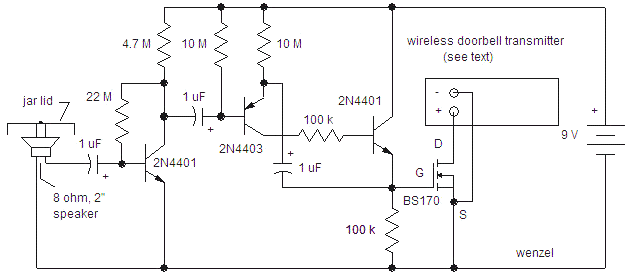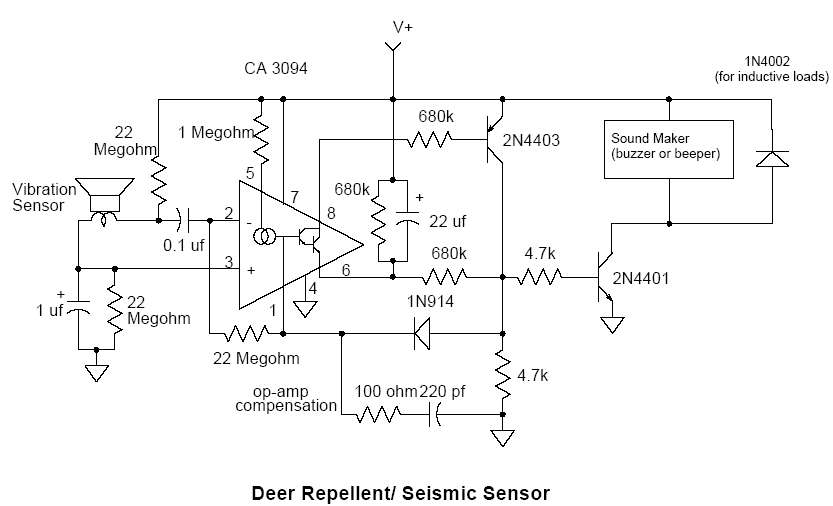

My original "Deer Repellent/ Seismic Sensor" recommended using a speaker with a weight glued to the cone as a vibration sensor (see bottom of page) but it recently occurred to me that the speaker could supply the mass itself. By gluing a standoff to the center of the cone, an inexpensive 2", 8 ohm speaker becomes a vibration sensor with a natural resonance below 100Hz which is quite good. My implementation is shown below:
After the epoxy cured, the speaker was hung in the middle of the lid from an empty instant ice tea jar. Be careful mounting the speaker! The cone is weak and cannot tolerate a lot of torque when you tighten the screw. Put some epoxy on the screw threads near the head and hand-tighten only. The epoxy will provide a firm mount and will seal the hole, too. Flexible wires lead from the speaker terminals to the circuit:
The circuit is similar in operation to my original design but without the now-obsolete CA3094 op-amp. This design is every bit as sensitive and uses ordinary discrete components. The output will drive any variety of buzzers, relays or other devices but my favorite is a Radio Shack wireless doorbell:

This transmitter for this "wireless remote door chime" has a couple of connections on the back that are in parallel with the pushbutton and shorting these contacts causes the bell to ring. One of the contacts has a positive voltage near 9 volts and this contact should go to the drain of the FET. The other should go to the negative battery connection. I used a couple of brass standoffs to space the circuit board above these terminals to mount the board. If you want a different load (like a 9 volt buzzer), connect the negative end to the drain and the positive end to the positive battery terminal. You can use a different battery to power the load, if desired. I decided to power my circuit from the battery in the transmitter so I drilled a small hole in the back and ran two wires out from the PCB where the battery wires attached. If you use a separate battery, the transmitter can be left "unmolested".
I wedged the transmitter into the jar with a piece of styrofoam then screwed on the lid. It will take a minute or so before the circuit reaches full sensitivity. But then the slightest jarring of the jar will ring the bell! The circuit will take a while to recover after a trigger, too. To protect a large area with the sensor set it over a pipe buried just beneath the surface. A footstep anywhere along the pipe will shake the sensor.
Parts Considerations:
Just about any modern bipolar transistors will work including the 2N3904 (NPN) and 2N3906 (PNP).
The output mosfet transistor may be just about any N-channel enhancement type including the common 2N7000 or older VN10KM.
The resistors are not critical at all and any type or size should work fine and reasonably close values are OK.
The 1uF capacitors may be just about any type, with a 16 volt aluminum electrolytic being the most likely choice. The amplifier stages will work with smaller values. Increase the value of the 1uF on the gate of the mosfet for a longer on-time, if desired.
The battery is an ordinary 9 volt rectangular type and no power switch is needed because the current drain is extremely low. You may share the battery in the transmitter.
The doorbell transmitter is a Radio Shack wireless doorbell but others should be adaptable. If you find one without the rear contacts, connect two wires to the back of the pushbutton and use a voltmeter to determine which wire has the positive voltage.
The speaker is an ordinary 2", 8 ohm speaker but others will work, too.
The jar is chosen to be tall enough to accommodate the long doorbell transmitter.
Theory of Operation:
The first transistor is a very low current, high gain audio amplifier that boosts the tiny signal from the speaker. When the signal is large enough, due to vibration, it pulls down the PNP base enough to turn it on slightly. Once that happens, regenerative action cause it and the third NPN to turn on fully. The voltage rises on the gate of the mosfet, turning it on. The capacitor in the emitter of the PNP discharges and the transistor turns off suddenly due to reverse regenerative action. It takes many seconds for the circuit to recover and be ready for another trigger.
Other Ideas:
The circuit is a very sensitive "changing voltage" detector and the input could be any number of sensors besides a speaker.
For sensing vibration, a piezo speaker could be used in place of the dynamic speaker.
An electret microphone could make a sensitive sound detector.
A photocell or pin photo diode could be used to sense a sudden change in light level.
A diode detector could alert you to the presence of a transmitter or cell phone.
The following circuit is my original design an is supplied for historical purposes. If you happen to have a few of the CA3094s, this is a great sensor!
Here is a simple sensor which can detect the seismic vibrations caused by a person or large animal walking nearby. A representative application for the sensor is a deer repellent for the vegetable garden. When a deer steps near the sensor a loud buzzer or beeper sounds for a few seconds startling the would-be vegetable thief away. The sensor also makes an effective intruder detector to catch trespassers as soon as they step on the property!

The unit is designed to consume minute amounts of power to provide many months
of unattended protection (practically set by the battery shelf life). The
seismic sensor is built from an ordinary 2 inch speaker by gluing a mass to the
speaker cone to lower its resonance frequency. A lid from a baby food jar with a
little extra weight glued to the inside will work fine.
The CA3094 I.C. is an unusual op-amp consisting of a programmable transconductance amplifier connected to a darlington transistor. In this circuit the darlington is combined with a pnp transistor to form a monostable timer which determines how long the buzzer sounds. When the ground shakes, the vibration sensing speaker generates a small voltage which is amplified causing the voltage on pin 1 to go high. The darlington in the IC and the 2N4403 turn on with regenerative feedback provided by the diode. The 2N4401 turns on, powering the buzzer until the monostable resets. The circuit may be used to activate a variety of devices including a relay to control line voltage devices, a transmitter to telemeter an alarm from a remote location, a battery- powered walkway light, or even one of those battery powered squirt guns! The output transistor may be replaced with a power darlington transistor for directly controlling higher current loads. The circuit may be built into ordinary plumbing PVC pipe or practically any weatherproof enclosure. A larger detection area may be accomplished by burying a long pole or PVC pipe just below the surface of the ground with the seismic sensor located above the pole. Vibrations will readily travel down the pole whenever a footstep occurs anywhere along its length. The seismic sensor may be replaced with other sensors for different applications. A photocell/ resistor divider will sense changes in light level, a microphone will sense fairly low sound levels, and a diode detector will sense a low-level RF field.